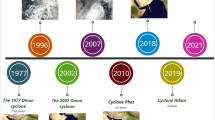Abstract
The main features of a cyclone that cause death and destruction are: (1) Storm surge, a rapid increase in sea level along the coast, primarily caused by the strong surface wind field of the cyclone as it approaches the coast, (2) the violent sustained wind and wind gusts and cyclone-spawned tornadoes, and (3) the heavy rain and consequent flooding. The paper describes the structure of a tropical cyclone of hurricane intensity and its damage potential, cyclone detection, tracking, forecasting and warning systems. It concludes that with over a hundred years of research and operational experience on cyclones available with the meteorological community and with theinsat and cyclone detection radar network, India has now an efficient cyclone warning system. This system would however benefit from further sophistication notably the use of Doppler Radars for cyclone wind field monitoring and an aircraft reconnaissance facility for probing cyclones. Research is needed to develop techniques for better forecasting of the tracks of cyclones more than a day ahead and also their intensity changes.
Cyclone disaster mitigation arrangements were organised in the maritime states of India only during the last 25 years. This relatively young field requires more developmental work, particularly in coastal area planning to reduce property losses, and exploration of alternative approaches to large-scale evacuation of the coastal population threatened by cyclones to distant temporary shelters.
Similar content being viewed by others
References
Ams 1993 Policy statement on hurricane detection, tracking and forecasting of the American Meteorological Society, as adopted by the Exeoutive Committee on 23 April 1993.Bull. Am. Meteorol. Soc. 74: 1377–1380
Anthes R A 1982 Tropical cyclones, their evolution, structure and effects.Meteorological monographs (Boston: Am. Meteorol. Soc.) vol. 19, no. 41
Dvorak V F 1975 Tropical cyclone intensity analysis and forecasting from satellite imagery.Mon. Weather Rev. 103: 420–430
Elsberry R L (ed.) 1987a Observation and analysis of tropical cyclones.A global view of tropical cyclones (Monterey,Ca: Naval Postgraduate School)
Elsberry R L (ed.) 1987b Tropical cyclone motion.A global view of tropical cyclones (Monterey,Ca: Naval Postgraduate School)
Gray W M 1979 Hurricanes, their formation, structure and likely role in tropical circulation.Meteorology over the tropical oceans (ed.) D B Shaw (Bracknell: R. Meteorol. Soc.)
Gray W M, Neumann C, Tsui T L 1991 Assessment of the role of aircraft reconnaissance on tropical cyclone analysis and forecasting.Bull. Am. Meteorol. Soc. 72: 1867–1883
Joseph P V, Ghosh S K, Sharma B L, Seshadri V R 1981 Report on the impact of cyclonic storm and storm surge near Paradeep. India Meteorological Department
Landsea C W 1993 A climatology of intense (or major) Atlantic hurricanes.Mon. Weather Rev. 121: 1703–1713
Mishra D K, Gupta G R 1976 Estimation of maximum wind speeds in tropical cyclones occuring in Indian seas.Indian J. Meteorol. Hydrol. Geophys. 27: 285–290
Raghavan S, Sen Sarma A K 1989dws- A satellite based warning system.Proceedings of the symposium on Preparedness, Mitigation and Management of Natural Disasters, pp. 4–27 to 4–30.
Southern R L 1979 The global socio-economic impact of tropical cyclones.Aust. Meteorol. Mag. 27: 175–195
Southern R L 1987 Tropical cyclone warning and mitigation systems.A global view of tropical cyclones (ed.) R L Elsberry (Monterey,Ca: Naval Postgraduate School)
Subramanian S K, Mohanan G 1992 Some features of the Bay cyclone of May 1990.Vayu Mandal 22: 97–102
Wmo 1990 Tropical cyclone warning systems WMO/TD No. 394, Report No. TCP-26, World Meteorological Organisation, Geneva
Author information
Authors and Affiliations
Rights and permissions
About this article
Cite this article
Joseph, P.V. Tropical cyclone hazards and warning and disaster mitigation systems in India. Sadhana 19, 551–566 (1994). https://doi.org/10.1007/BF02835639
Issue Date:
DOI: https://doi.org/10.1007/BF02835639




